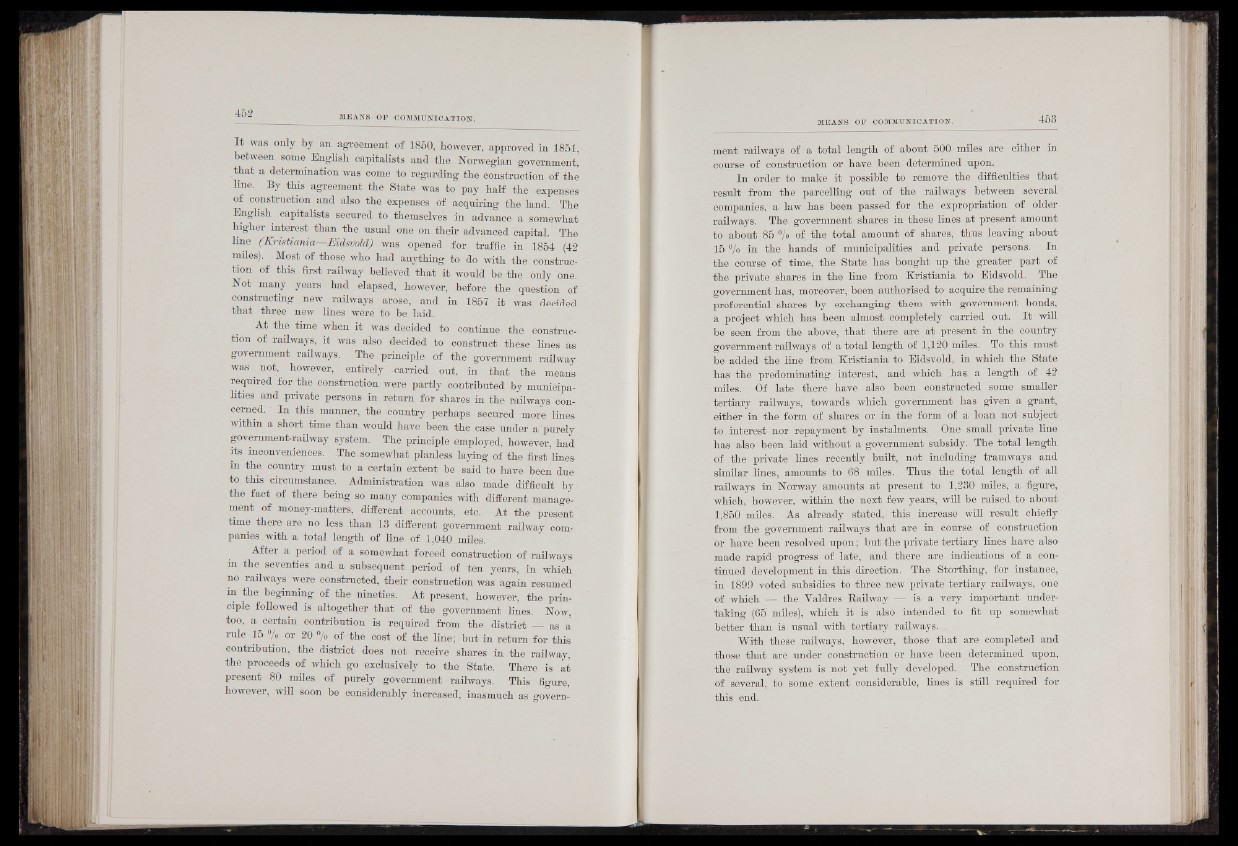
I t was only by an agreement of 1850, however, approved in 1851,
between some English capitalists and the Norwegian government’
that a determination was come to regarding the construction of the
line. By this agreement the State was to pay half the expenses
of construction and also the expenses of acquiring the land. The
English capitalists secured to themselves in advance a somewhat
higher interest than the usual one on their advanced capital. The
line (Kristiania—Eidsvold) was opened for traffic in 1854 (42
miles). Most of those who had anything to do with the construction
of this first railway believed that it would be the only one.
Not many years had elapsed, however, before the question of
constructing new railways arose, and in 1857 it was decided
that three new lines were to be laid.
At the time when it was decided to continue the construction
of railways, it was also decided to construct these lines as
government railways. The principle of the government railway
was not, however, entirely carried out, in that the means
required for the construction were partly contributed by municipalities
and private persons in return for shares in the railways concerned.
In this manner, the country perhaps secured more lines
within a short time than would have been the case under a purely
government-railway system. The principle employed, however, had
its inconveniences. .The.somewhat planless laying of the first lines
in the country must to a certain extent be said to have been due
to this circumstance. Administration was also made difficult by'
the fact of there being so many companies with different management
of money-matters, different accounts, etc. At the present
time there are no less than 13 different government railway companies
with a total length of line of l,04(Lmiles.
After a period of a somewhat forced construction of railways
m the seventies and a subsequent period of ten years, in which
no railways were constructed, their construction was again resumed
m the beginning of the nineties. At present, however, the principle
followed is altogether that of the government lines. Now,
too, a certain contribution is required from the district — as a
rule 15 °/o or 20 °/o of the cost of the line; but in return for this
contribution, the district does not receive shares in the railway,
the proceeds of which go exclusively to the State. There is at
present 80 miles of purely government railways. This figure,
however, will soon be considerably increased, inasmuch as government
railways of a total length of about 500 miles are either in
course of construction or have been determined upon.
In order to make it possible to remove the difficulties that
result from the parcelling out of the railways between several
companies, a law has been passed for the expropriation of older
railways. The government shares in these lines at present amount
to about 85 °/o of the total amount of shares, thus leaving about
15 % in the hands of municipalities and private persons. In
the course of time, the State has bought up the .greater part of
the private shares in the line from Kristiania to Eidsvold. The
government has, moreover, been authorised to acquire the remaining
preferential shares by exchanging them with government bonds,
a project which has been almost completely carried out. I t will
be seen from the above, that there are at present in the country
government railways of a total length of 1,120 miles. To this must
be added the line from Kristiania to Eidsvold, in which the State
has the predominating interest, and which has a length of 42
miles. Of late there have also been constructed some smaller
tertiary railways, towards which government has given a grant,
either in the form of shares or in the form of a loan not subject
to interest nor repayment by instalments. One small private line
has also been laid without a government subsidy. The total length
of the private lines recently built, not including tramways and
similar lines, amounts to 68 miles. Thus the total length of all
railways in Norway amounts at present to 1,230 miles, a figure,
which, however, within the next few years,' will be raised to about
1,850 miles. As already stated, this increase will result chiefly
from the government railways that are in course of construction
or have been resolved upon; but the private tertiary lines have also
made rapid progress of late, and there are indications of a continued
development in this direction. The Storthing, for instance,
in 1899 voted subsidies to three new private tertiary railways, one
of which — the Yaldres Bail way — is a very important undertaking
(65 miles), which it is also intended to fit up somewhat
better than is usual with tertiary railways.
With these railways, however, those that are completed and
those that are under construction or have been determined upon,
the railway system is not yet fully developed. The construction
of several, to some extent considerable, lines is still required for
this end.